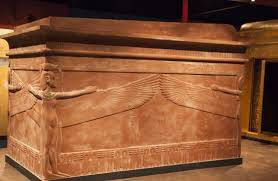102 Years Ago, One of the All-Time Greatest Archaeological Discoveries Was Made
One hundred and two years ago, in 1922, one of the most significant archaeological discoveries in modern history was made in the Valley of the Kings, Egypt. The discovery of the tomb of Tutankhamun, the boy king, by British archaeologist Howard Carter, stunned the world and continues to captivate historians, archaeologists, and the public to this day. The find not only reshaped our understanding of ancient Egyptian history but also revealed an extraordinary wealth of artifacts, art, and treasures that provided a rare glimpse into the life of an ancient civilization.
The Search for the Lost Tomb
The story of Tutankhamun's tomb begins in 1917 when Howard Carter, who had spent years working in Egypt as an archaeologist, began searching for a lost tomb that had been mentioned in ancient texts but had never been found. Carter was hired by Lord Carnarvon, a British aristocrat with a passion for Egyptology and a financial backer of archaeological expeditions. Together, they focused their attention on the Valley of the Kings, a burial site used by Pharaohs and noble figures during the New Kingdom (16th to 11th centuries BCE). For years, Carter had searched unsuccessfully for the tomb, and with most of the royal tombs already discovered or looted, his search was deemed unpromising.
However, in November 1922, after years of frustration, Carter’s perseverance finally paid off. As he and his team excavated the area near the tomb of Ramses VI, they uncovered a set of stone steps that led down into an undisturbed tomb. On November 4, 1922, Carter peered through a small hole into the sealed chamber and famously said to Lord Carnarvon, “I see wonderful things.†Those words would mark the beginning of one of the most extraordinary finds in archaeological history.
The Tomb of Tutankhamun
The tomb, designated KV62, was found remarkably intact, a rarity in the world of ancient Egyptian tombs. Most tombs of pharaohs had been plundered in antiquity, with precious objects and the mummified bodies of kings being stolen long before they could be studied. But Tutankhamun's tomb was untouched, its riches and artifacts still in place, as though the young king had only just been buried.
Inside the tomb, Carter and his team found a vast array of objects, including statues, jewelry, weapons, furniture, and more than 5,000 items in total. Among the most famous discoveries were Tutankhamun’s golden funerary mask, his elaborate sarcophagus, and a set of golden chariots. The mask, weighing about 22 pounds of solid gold, is one of the most iconic images of ancient Egypt, and its intricate design, with inlaid lapis lazuli and glass, showcases the craftsmanship and wealth of the period.
The tomb also revealed the king's mummified body, which was found inside three nested coffins. The central coffin, made of solid gold, encased the king's body, which was wrapped in linen bandages and surrounded by ritual items intended to protect him in the afterlife. The discovery of the tomb allowed experts to study the mummification process in great detail, offering crucial insights into ancient Egyptian burial practices.
Tutankhamun: The Boy King
Tutankhamun, who ruled Egypt from 1332 to 1323 BCE, was not one of Egypt’s most powerful or famous pharaohs, and his reign is largely considered uneventful. He ascended the throne at a very young age—just eight or nine years old—and ruled until his untimely death at around 18 or 19. His death remains shrouded in mystery, with theories ranging from an accident to a possible murder. Despite his relatively short and relatively uneventful reign, the discovery of his tomb turned him into one of the most famous pharaohs in history, simply because of the treasures and the wealth of knowledge it provided.
One of the major reasons for the enduring fascination with Tutankhamun is the extraordinary quality and quantity of the artifacts found in his tomb. These objects not only illustrate the grandeur of the Egyptian civilization but also offer an intimate look at the material culture, daily life, and religious practices of the time. Items found in the tomb included games, weapons, clothing, food, and even models of servants—all intended to accompany the young king into the afterlife.
The tomb also provided valuable evidence of the religious upheaval that occurred during Tutankhamun's time. His father, Akhenaten, had attempted to revolutionize Egypt’s religious practices by promoting the worship of the sun god Aten over the traditional polytheistic pantheon. However, after Akhenaten's death, Tutankhamun and his advisors swiftly returned Egypt to its traditional beliefs, reintroducing the worship of the god Amun and other deities. The shift is reflected in the art and inscriptions within Tutankhamun's tomb, which highlight the return to orthodoxy.
The Curse of the Pharaohs?
The discovery of Tutankhamun's tomb was followed by a series of mysterious deaths and misfortunes, leading to the popular belief in a "curse" of the pharaohs. Lord Carnarvon, who had funded the excavation, died shortly after the tomb was opened, and several members of Carter’s team also met untimely deaths in the years that followed. This series of events was sensationalized by the media and added an element of intrigue and mystery to the discovery, further cementing its place in popular culture.
However, modern science suggests that the deaths were likely due to natural causes, such as infections, rather than any curse. The phenomenon of “the curse†remains a part of the mythology surrounding the tomb, though it is widely considered to be a product of coincidence and sensationalism.
Legacy of the Discovery
The discovery of Tutankhamun’s tomb was not only a triumph for archaeology but also a watershed moment in the study of ancient Egypt. The riches and artifacts provided an unparalleled opportunity to learn about the civilization’s art, religion, daily life, and burial practices. Moreover, the discovery sparked a global fascination with Egyptology, drawing tourists and scholars to the Valley of the Kings and other ancient Egyptian sites.
Today, the treasures of Tutankhamun are housed in various museums, including Cairo’s Egyptian Museum, where they continue to inspire awe and wonder. The tomb itself remains a key site for archaeological study, and ongoing research continues to reveal new insights into the life and times of one of ancient Egypt's most famous rulers.
As we mark the 102nd anniversary of this monumental discovery, the legacy of Tutankhamun and his tomb endures, reminding us of the enduring allure of ancient Egypt and the transformative power of archaeology in uncovering the mysteries of our shared human history.


